
Carex is a vast genus of over 2,000 species of grass-like plants in the family Cyperaceae, commonly known as sedges. Other members of the family Cyperaceae are also called sedges, however those of genus Carex may be called true sedges, and it is the most species-rich genus in the family. The study of Carex is known as caricology.
Euhadra sadoensis is a species of air-breathing land snail, a terrestrial pulmonate gastropod mollusk in the family Bradybaenidae. This species is found in Japan.
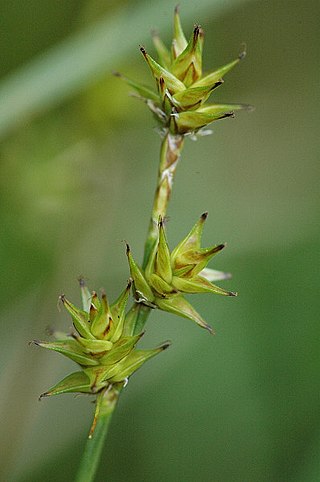
Carex echinata is a species of sedge known by the common names star sedge and little prickly sedge.
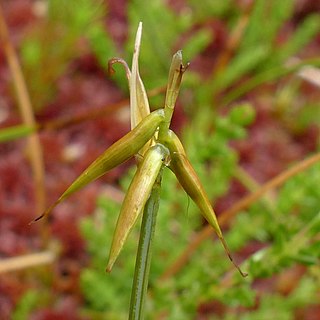
Carex pauciflora, the few-flowered sedge, is a perennial species of sedge in the family Cyperaceae native to bogs and fens in cool temperate, subarctic, and mountainous regions of the Northern Hemisphere. The specific epithet pauciflora refers to the Latin term for 'few flowered'.
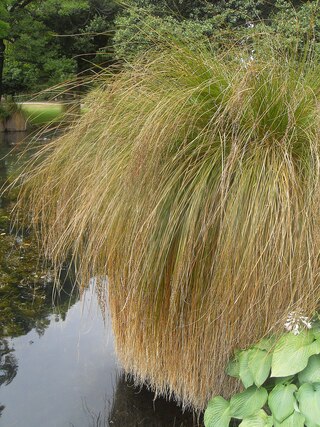
Carex secta is a sedge from the Cyperaceae family that is endemic to New Zealand. It grows in wetlands. Its Māori names include purei, pukio and makura.

Carex riparia, the greater pond sedge, is a species of sedge found across Europe and Asia. It grows in a variety of wet habitats, and can be a dominant species in some swamps. It is Britain's largest Carex, growing up to 130 cm tall, with glaucous leaves up to 160 cm long. It hybridises with a number of other Carex species, including the closely related Carex acutiformis – the lesser pond sedge. A variegated cultivar is grown as an ornamental grass.
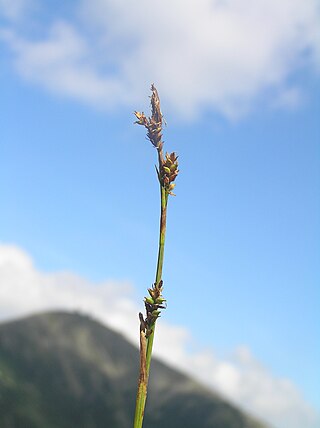
Carex vaginata is a species of sedge known by the common name sheathed sedge.

Carex bohemica is a species of sedge, native to Europe, Siberia, and northern Asia to Japan, and it was introduced to Sweden. It prefers to grow in mud flats. It is called Zypergras-Segge in German.

Carex dioica, the dioecious sedge, is a species of flowering plant in the genus Carex, native to Iceland, the Faroes, Svalbard, nearly all of Europe, western Siberia, and the Altai. It prefers to live in calcareous fens.
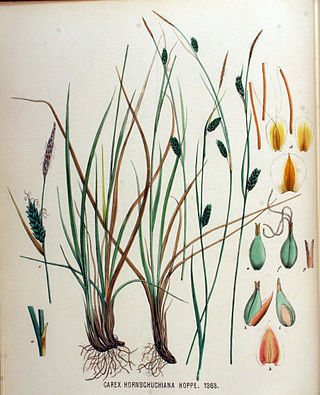
Carex hostiana, the tawny sedge, is a species of flowering plant in the genus Carex, native to Europe and northeast Canada, and extinct in Massachusetts. It is a member of the Carex flava species complex.

Carex angustisquama is a tussock-forming species of perennial sedge in the family Cyperaceae. It is native to northern parts of Honshu in Japan.
Carex bodinieri is a tussock-forming species of perennial sedge in the family Cyperaceae. It is native to Japan and eastern parts of China.

Carex curvicollis is a tussock-forming species of perennial sedge in the family Cyperaceae. It is native to parts of Japan.
Carex capilliformis is a tussock-forming species of perennial sedge in the family Cyperaceae. It is native to central parts of China.
Carex cylindrostachys is a tussock-forming species of perennial sedge in the family Cyperaceae. It is native to parts of Yunnan and Sichuan in China. Its common name in Chinese is zhu sui tai cao, or 柱穗薹草.
Carex davidi is a tussock-forming species of perennial sedge in the family Cyperaceae. It is native to parts of China.
Carex delavayi is a tussock-forming species of perennial sedge in the family Cyperaceae. It is native to parts of south central China.

Carex dissitiflora is a tussock-forming species of perennial sedge in the family Cyperaceae. It is native to parts of Japan and Taiwan.
Carex fastigiata is a tussock-forming species of perennial sedge in the family Cyperaceae. It is native to parts of Tibet, Nepal and China.
Carex fulta is a tussock-forming species of perennial sedge in the family Cyperaceae. It is native to parts of Honshu in Japan.











